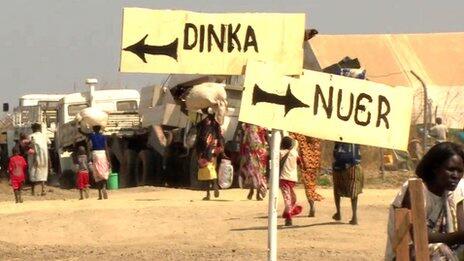
South Sudan separates Dinka and Nuer as they arrive"
By Steve Sailer
01/11/2014
 |
| @alunmacdonald: "Most depressing photo of the day — a sign at UN camp in South Sudan separates Dinka and Nuer as they arrive" |
From the New York Times:
Ethnic Segregation at a U.N. Camp in South Sudan
By SOMINI SENGUPTA and ROBERT MACKEY
Reporting from South Sudan on Friday, the BBC correspondent Alastair Leithead discovered that civilians taking refuge from fighting at a United Nations base outside the town of Bentiu were being segregated along ethnic lines by the peacekeepers.
One image from the video report filed by the BBC News crew, showing a hand-painted sign directing members of the Dinka and the Nuer tribes to opposite sides of the camp, caught the attention of Alun McDonald, an Oxfam media officer who has worked with refugees in South Sudan.
According to Mr. Leithead, civilians from both tribes have been forced to seek safety as the fighting raged between forces loyal to President Salva Kiir — a member of the country’s largest ethnic group, the Dinka — and followers of his former vice president, Riek Machar, a Nuer. …
Still, many close observers of the conflict were taken aback by the partition of the camp. In a conversation on Twitter, both Rebecca Hamilton, a human rights lawyer who has written about the impact of citizen advocacy on U.S. policy in the region, and Amir Ahmad Nasr, a Sudanese blogger, criticized the United Nations Mission in South Sudan for dividing the civilians.
 |
| Malvina Hoffman’s "Nuer Warrior" |
I don’t know. Sounds pretty prudent to me.
First, Dinkas and Nuers speak somewhat different languages. The Wikipedia article on "Dinka Language" says, "The closest non-Dinka language is Nuer, the language of the Dinka’s traditional rivals."
Second, they are fighting right now.
Third, the Nuers and the Dinkas fought throughout the 19th Century until the British arrived and saved the Dinka from complete conquest. This is less obscure than it sounds because rivalries between and among the Nuers and Dinkas are the subject of the classic works on "segmentary lineage" among the Nuer by anthropologist E.E. Evans-Pritchard (the father of colorful Daily Telegraph reporter Ambrose Evans-Pritchard, by the way). See for example, Marshall D. Sahlins' 1961 article "The Segmentary Lineage: An Organization of Predatory Expansion." The Nuer are a canonical example in the anthropological literature of me against my brother, my brother and I against my cousin, my cousins, brother, and I against the world.
The Nuer are pretty good though at coming together with distant cousins for the purposes of kicking around the poor Dinkas. Nuer tribes were traditionally organized on a larger scale that allowed Nuers to put larger armies in the field and defeat the Dinkas. Both sides take the cattle of each other, but the dominant Nuer do it by battle and the poor Dinka fight back by theft.
The ruling mindset of white people writing about Africa is that Africans have no agency: Africans are merely robotic vehicles for the malign influence of white people. Thus, if white people pay for a refugee camp for Dinkas and Nuers, this pair of signs can then be held responsible for all future conflicts between the tribes. The alternative is to assume that Africans have some responsibility for the state of Africa, but, considering the state of Africa, that would be racist.
In truth, the Nuer were always been proud of their ability to push around the Dinka and take his cattle. They would consider the conventional wisdom of themselves as pitiful victims being manipulated by white stereotypes into fighting the Dinka as an insult.
This is a content archive of VDARE.com, which Letitia James forced off of the Internet using lawfare.